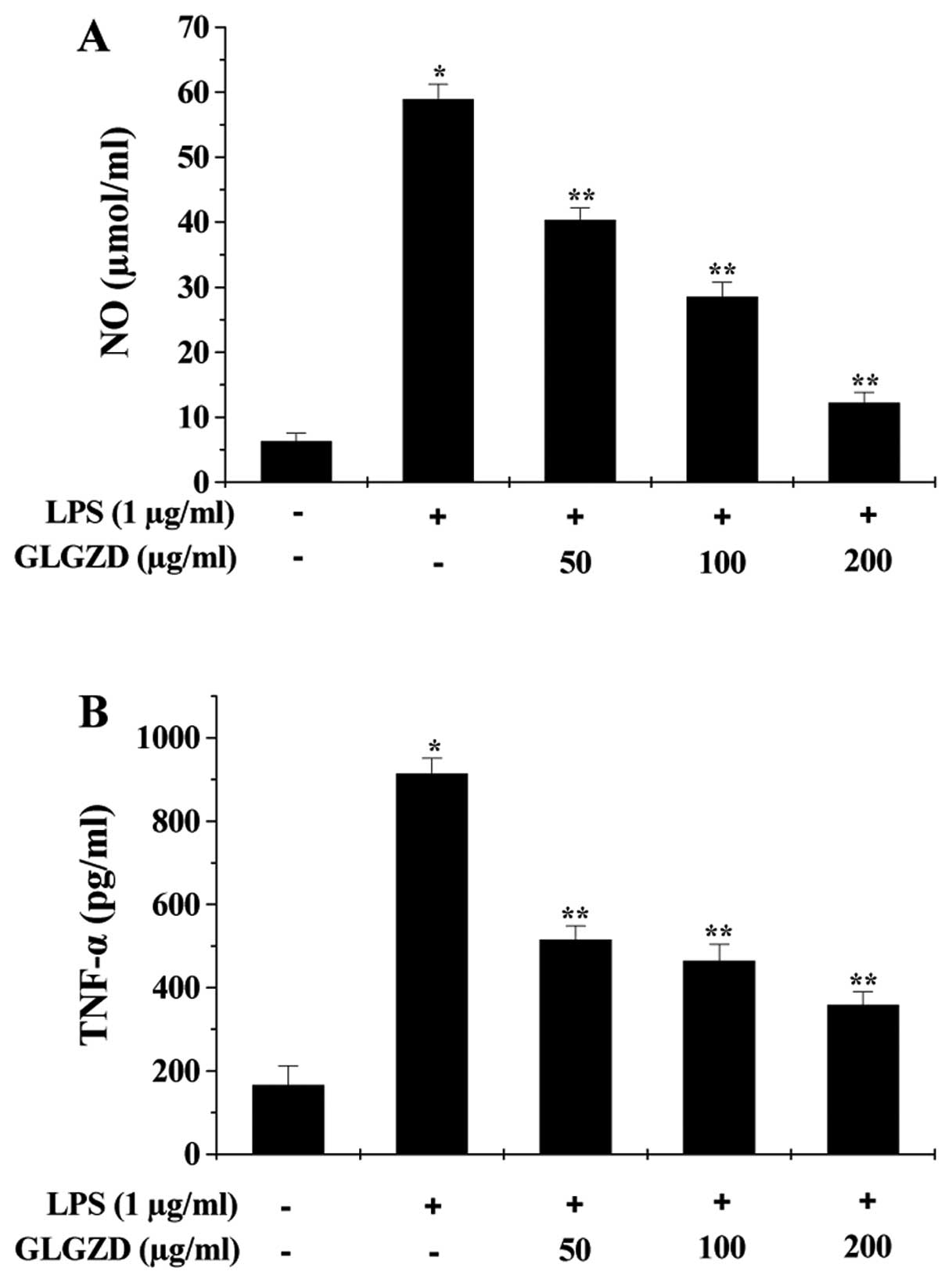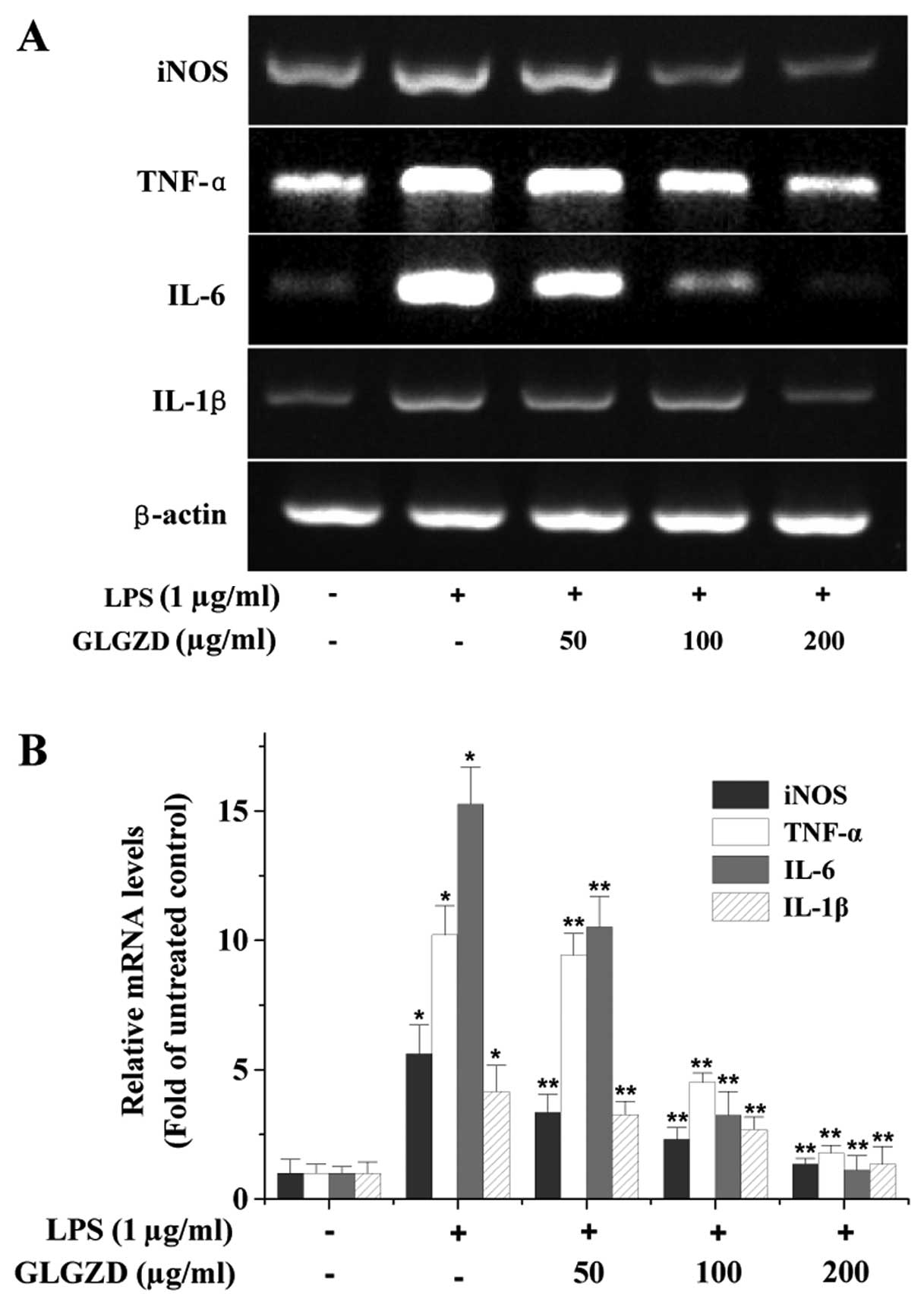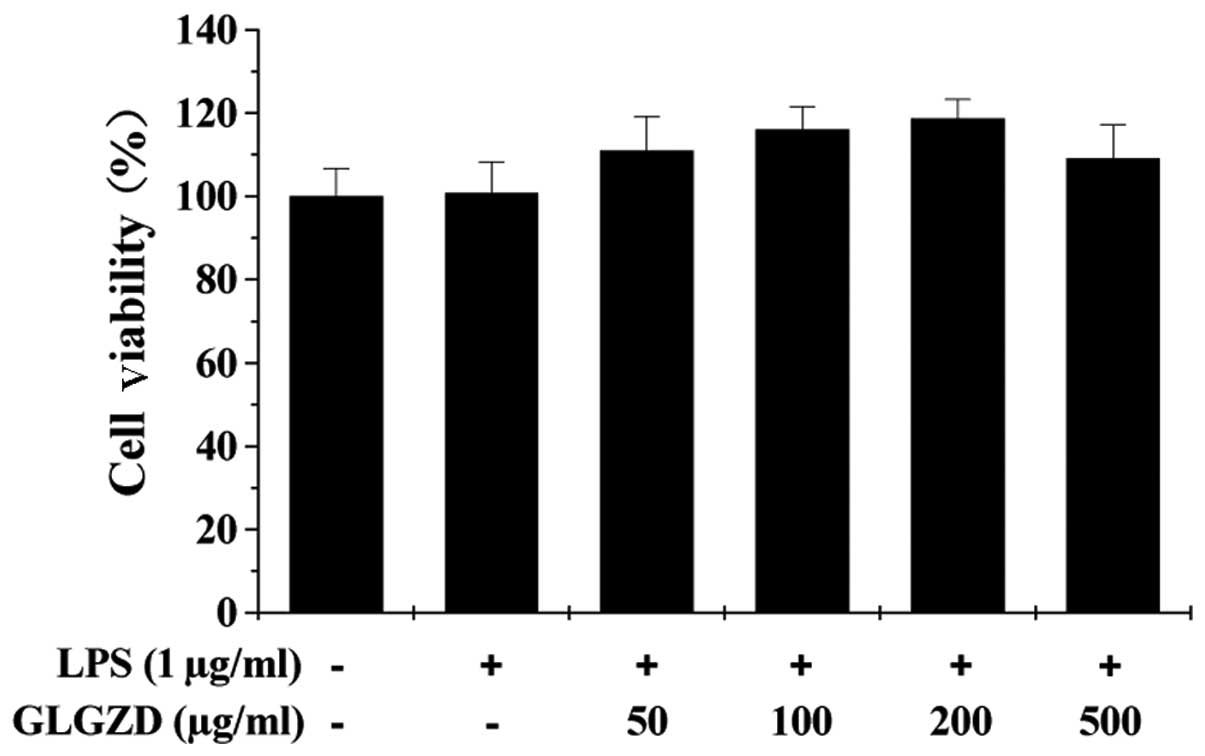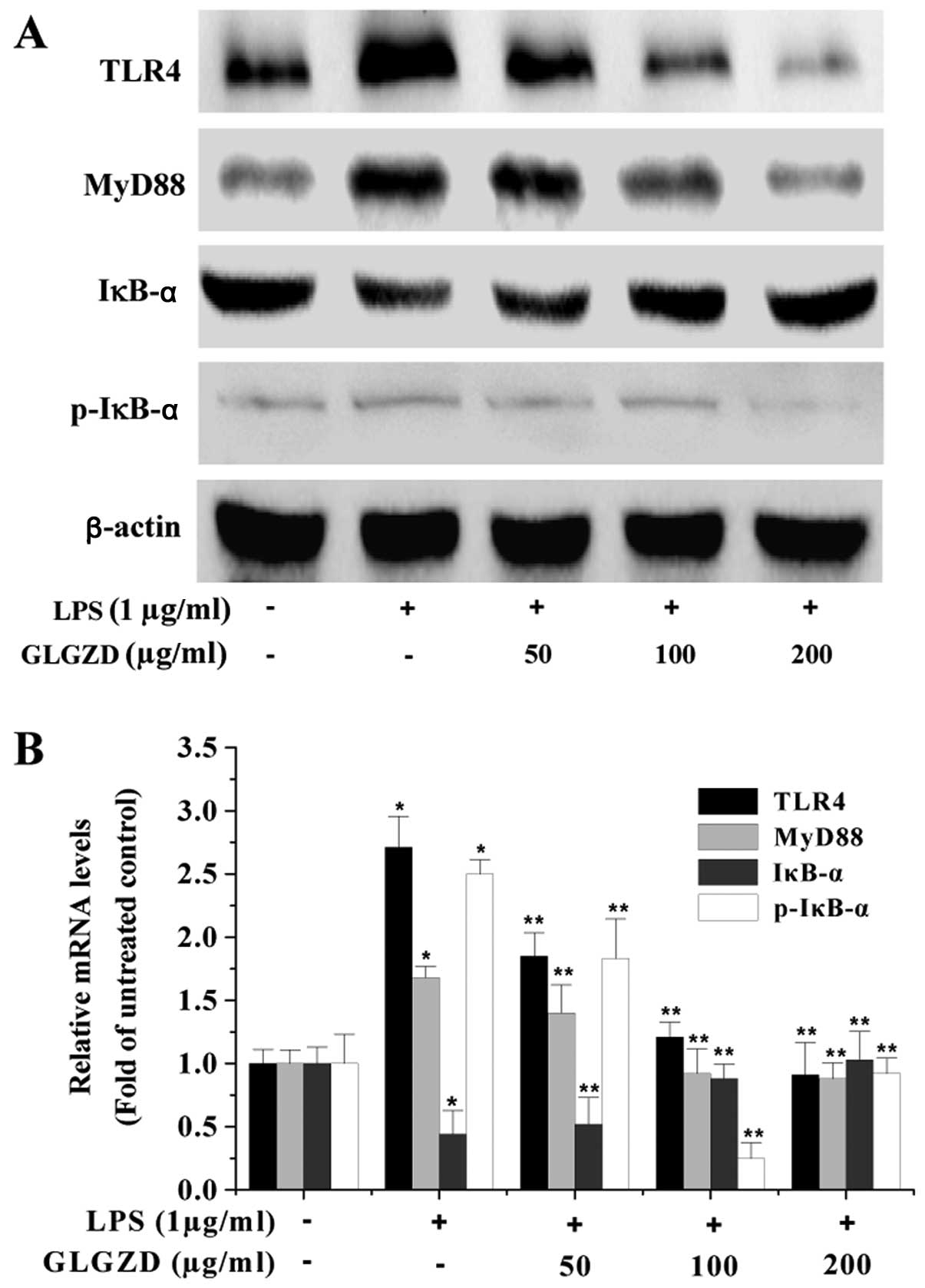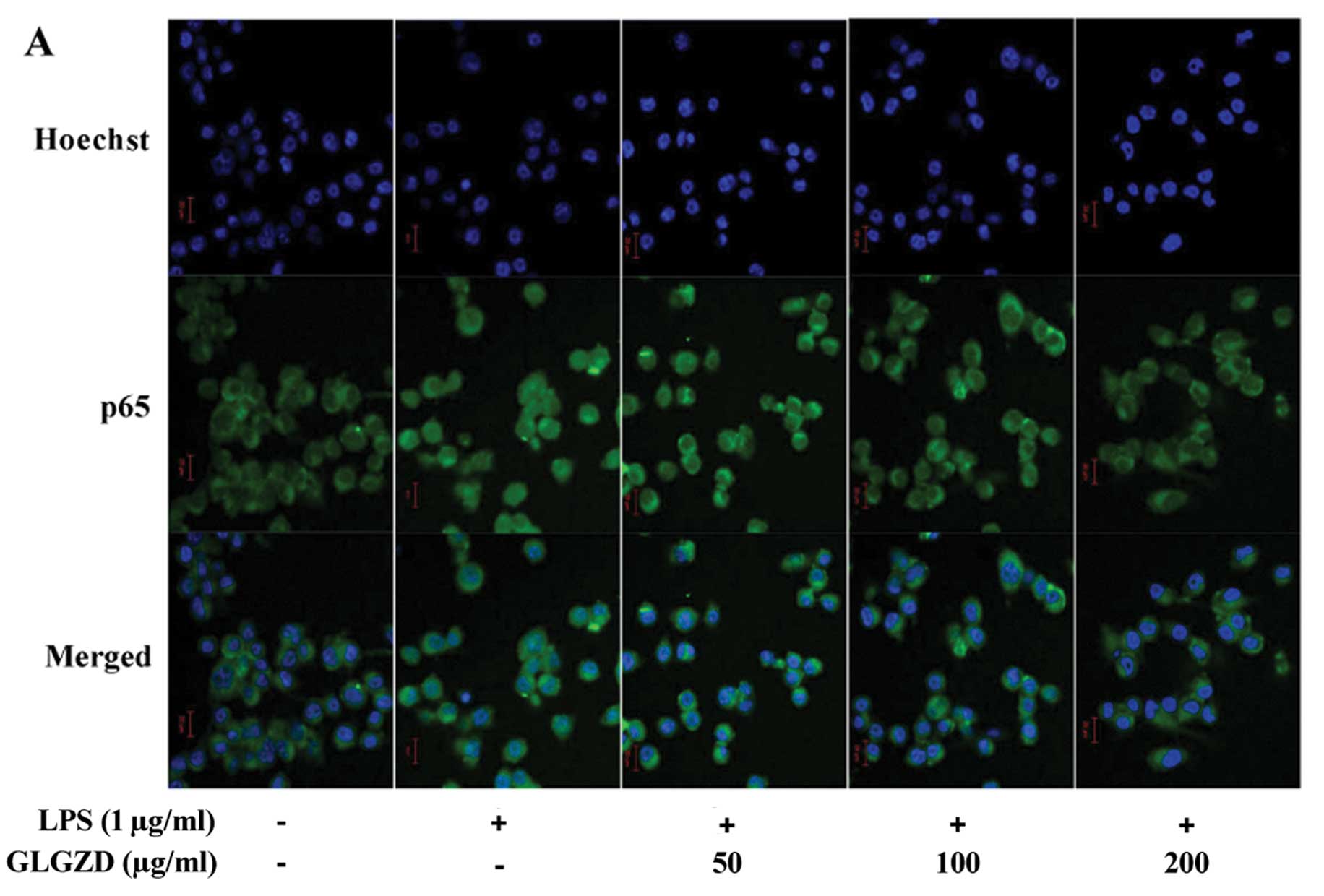Gua Lou Gui Zhi decoction suppresses LPS-induced activation of the TLR4/NF-κB pathway in BV-2 murine microglial cells
- Authors:
- Published online on: April 5, 2013 https://doi.org/10.3892/ijmm.2013.1331
- Pages: 1327-1332
Abstract
Introduction
Stroke is the second most common cause of death and the major cause of disability worldwide (1). Inflammatory reaction has been shown to play an important role in secondary brain damage after stroke, which is believed to be the consequence of microglial activation (2,3). Microglial cells are generally considered to be the resident immunocompetent cells of the central nervous system (CNS), and over-activation of microglia can induce significant and highly detrimental neurotoxic effects through excessive production of a large array of cytotoxic factors such as superoxide, nitric oxide (NO), tumour necrosis factor-α (TNF-α), interleukin (IL)-1β and IL-6 (4). In addition, previous studies have demonstrated that a decrease in the secretion of pro-inflammatory mediators in microglia attenuates the severity of neuro-degenerative diseases including ischemic stroke (5,6). LPS, an inducer of inflammation, has been frequently employed to stimulate microglia to construct a useful model for the study of mechanisms that underlie neuronal injury (7). Toll-like receptor 4 (TLR4) is well known as the unique receptor for lipopolysac-TLR4) is well known as the unique receptor for lipopolysaccharide (LPS), which transduces immune-related signals to the nucleus via activating transcription factors such as nuclear factor-κB (NF-κB). In unstimulated cells, NF-κB is sequestered in the cytosol via interaction with inhibitory IκB proteins. However, when cells receive pathological stimuli, IκB protein is phosphorylated resulting in its ubiquitination and degradation, which in turn releases sequestered NF-κB, leading to its translocation to the nucleus where it positively regulates the expression of various pro-inflammatory mediators (8–10). Therefore, anti-inflammatory treatment may reduce ischemic brain injury and enhance stroke recovery.
Gua Lou Gui Zhi decoction (GLGZD) is a classical traditional Chinese formula that was first prescribed in Eastern Han Dynasty, around 210 AD, which consists of a combination of six herbs, including Trichosanthis Radix, Ramulus Cinnamomi, Paeonia lactiflora, Glycyrrhiza, Zingiber officinale Roscoe and Fructus Jujubae. GLGZD has long been used in China to clinically treat post-stroke disabilities such as muscular spasticity (11–13). However, the mode of its action remains largely unclear. Using LPS-stimulated microglial BV-2 cells as an in vitro inflammatory model of neural cells, in the present study we evaluated the anti-inflammatory effect of GLGZD and investigated the underlying molecular mechanisms.
Materials and methods
Materials and reagents
LPS (from Escherichia coli 055:B5) and 3-[4,5-dimethyl-2-thiazolyl]-2,5-diphenyltetrazolium bromide (MTT) were obtained from Sigma-Aldrich (St. Louis, MO, USA). Fetal bovine serum (FBS), Dulbecco’s modified Eagle’s medium (DMEM), penicillin, streptomycin, 0.05% (w/v) trypsin/EDTA, and phosphate-buffered saline (PBS) were obtained from Gibco-BRL (Gaithersburg, MD, USA). Cytokine (IL-6, TNF-α and IL-1β) ELISA kits were purchased from R&D Systems (Minneapolis, MN, USA). Antibodies for western blot analysis included: i) TLR4 antibody (rodent-specific) rabbit polyclonal antibody; ii) MyD88 (D80F5) rabbit mAb; iii) inhibitor of κBα (IκBα) (L35A5) mouse mAb (amino-terminal antigen); iv) phospho-IκBα (Ser32/36) (5A5) mouse mAb; v) anti-β-actin (8H10D10) mouse mAb; vi) horseradish peroxidase (HRP)-conjugated secondary antibodies (all from Cell Signaling Technology, Beverly, MA, USA). The antibody for immunofluorescence was NF-κB p65 (F-6) (Santa Cruz Biotechnology, Inc., Santa Cruz, CA, USA).
Preparation of water extract from GLGZD
Medicinal plants were supplied by Guo Yi Tang Chinese Herbal Medicine Store (Fujian, China) for the preparation of the GLGZD water extract. The preparation was a mixture of six crude plant extract ingredients soaked in (5-fold of the plant) double distilled water (DDW) for 30 min. The mixture was heated to 100°C for 1 h, and the decoction was filtrated. The filtrates obtained from two cycles of the procedures were mixed, then filtered and concentrated using a rotary evaporator (Model RE-2000; Yarong Biochemistry Instrument Co., Shanghai, China). The extract of GLGZD was obtained by a spraying desiccation method using a spray dryer (Model B-290; Büchi Labortechnik AG, Flawil, Switzerland). The stock and working concentrations of GLGZD were prepared by dissolving the extract in culture media to a concentration of 50 mg/ml and 50, 100, 200 μg/ml.
Cell culture and treatment
A murine BV-2 microglial cell line [purchased from the American Type Culture Collection, Manassas, VA, USA] was maintained in DMEM supplemented with FBS (10%), 100 U/ml penicillin and 100 μg/ml streptomycin. Cells were incubated in culture medium at 37°C in a 95% atmospheric air and 5% CO2 humidified atmosphere. Briefly, the numbers of viable cells were evaluated by counting trypan blue-excluding cells that were then plated at a density of 1×105 cells/well in 96-well trays, 2×105 cells/well in 24-well trays, or plated at a density of 5×105 cells/well in 6-well trays (for remaining experiments), incubated at 37°C for 24 h, and given a fresh change of medium. Cells were then incubated with or without LPS (1 μg/ml) in the presence of various concentrations of GLGZD (50, 100, 200 or 500 μg/ml) at 37°C for an additional 24 h, and in all experiments, cells were serum starved for 4 h prior to the treatment. The cultured cells were treated with LPS with or without GLGZD for 24 h (for ELISA), or for 12 h (for RT-PCR), or for 1 h for NF-κB translocation activity and western blotting for relative protein expression.
Cytotoxity assay
Microglial BV-2 cells were grown in 96-well plates and then incubated with or without LPS (1 μg/ml) in the presence of GLGZD at various concentrations for 24 h. MTT assay was used to measure the viability of the cells. MTT is a pale yellow substrate that produces a dark blue formazan product when incubated with living cells; an MTT ring is cleaved in active mitochondria, which occurs only in living cells. After the supernatants were removed for nitrite determination, cells were incubated at 37°C with MTT (0.05 mg/ml) for 4 h. The resulting color was assayed at 570 nm using a microplate absorbance reader (EXL 8008, Germany).
Determination of nitrite production
Inducible NO synthase (iNOS)-derived NO release is one of the major contributing factors during the inflammatory process in cerebral ischemic injury (14,15). Nitrite production was assessed by the Griess reaction (16). In brief, each 50 μl aliquot of the above-mentioned culture supernatants was collected and mixed with an equal volume of Griess reagent [0.1% N-(1-naphthyl)-ethylenediamine, 1% sulfanilamide in 5% phosphoric acid] and incubated at room temperature (RT) for 10 min. Absorbance at 540 nm was measured in a microplate absorbance reader. Nitrite concentration was determined from a sodium nitrite standard curve.
Measurement of inflammatory cytokines
BV-2 cells were plated in a 24-well cell culture plate and incubated with GLGZD water extract (50, 100 and 200 μg/ml) in the presence or absence of LPS (1 μg/ml) for 24 h. Following the manufacturer’s instructions, a volume of 1 ml of culture-medium supernatant was collected for measurement of the concentration levels of IL-6, TNF-α and IL-1β by the relevant ELISA kit.
Reverse transcription-polymerase chain reaction (RT-PCR)
Total RNA was extracted from cultured microglial cells by using TRIzol reagent (Invitrogen, Carlsbad, CA, USA) and following the standard protocol. Purity and integrity of the RNA were assessed using a NanoDrop reader. Subsequently, first-strand cDNA synthesis was performed with 2 μg total RNA using RevertAid™ H Minus First Strand cDNA Synthesis Kit (Fermentas, St. Leon-Rot, Germany) according to the manufacturer’s instructions. The obtained cDNA was used to determine the mRNA levels of TNF-α, IL-6, IL-1β and iNOS by a PCR kit (Fermentas). β-actin was used as an internal control.
Western blot analysis
BV-2 cells were plated overnight in 6 culture flasks and were then further incubated in serum-free medium for at least 4 h before treatments. After washing with cold PBS for three times, cells were lysed in RIPA buffer containing protease inhibitor PMSF (Roche Diagnostics, Mannheim, Germany). The content of the cells was pooled and centrifuged for 10 min at 12,000 × g and stored at −80°C. The protein concentration of the lysates was measured using BCA quantification assay (Pierce, Rockford, IL, USA). Proteins (50 μg) were separated using 12% (10% for TLR4 analysis) SDS-PAGE and transferred to PVDF membranes with a 0.45-μm pore size (IPVH00010; Millipore, Billerica, MA, USA). The membranes were incubated with primary antibodies overnight at 4°C: rabbit TLR4 monoclonal Ab, rabbit myd88, mouse IκBα, phospho-IκBα, β-actin monoclonal Ab (1:1,000) diluted in immunoblot buffer (TBS containing 0.05% Tween-20 and 5% non-fat dry milk). Following washing with TBST three times, membranes were incubated with the secondary antibody HRP-conjugated anti-mouse (or rabbit) IgG (1:1,000) for 1 h at RT. After washing, the blots were detected with Chemiluminescence (ECL)-Plus (RPN2132; GE Healthcare Life Sciences, Pittsburgh, PA, USA) for 1 min using a camera along with the VersaDoc System (Bio-Rad, Hercules, CA, USA). The pixel intensities of the immunoreactive bands were quantified using the percentage adjusted volume feature of Quantity One 5.4.1 software (Bio-Rad). Data are expressed as a ratio of the intensity of the band of the protein of interest over the intensity of the band of the loading control protein (β-actin).
Double-immunofluorescence labeling assay
For the detection of intracellular location of NF-κB p65, BV-2 cells were cultured on sterile glass coverslips and treated with GLGZD and LPS as described above. Following the various treatments, BV-2 cells were fixed with 4% paraformaldehyde in PBS for 30 min. After rinsing with PBS for three times, the cell membrane was permeabilized with 0.1% Triton X-100 for 2 min, and the coverslips with adherent cells were submitted to the double-immunofluorescence labeling assay. BV-2 cells were incubated with Hoechst (dilution 1:50,000; Sigma-Aldrich) plus NF-κB p65 (sc-8008, dilution 1:50; Santa Cruz Biotechnology, Inc.). The fluorescence signals were detected and analyzed using laser scan confocal microscopy (LSM 700; Carl Zeiss, Göttingen, Germany).
Statistical analysis
Data are expressed as means ± SD. One-way ANOVA was used when comparing the data obtained from the different experimental conditions. In vitro experiments were conducted in triplicates; representative results are shown. A P-value of <0.05 was considered to indicate a statistically significant result.
Results
GLGZD inhibits the LPS-induced inflammatory response in microglial BV-2 cells
We first evaluated the effect of GLGZD on LPS-induced inflammation in BV-2 cells by measuring the production of NO and secretion levels of pro-inflammatory cytokines (TNF-α, IL-6 and IL-1β). As shown in Fig. 1, LPS stimulation for 24 h significantly induced the release of NO, TNF-α, IL-6 and IL-1β, indicating an inflammatory response in BV-2 cells. However, the LPS-induced inflammation was significantly inhibited by GLGZD treatment in a dose-dependent manner. To further verify these observations, we determined the effect of GLGZD on the mRNA expression of the pro-inflammatory factors. As shown in Fig. 2, LPS stimulation profoundly increased the mRNA expression of iNOS, TNF-α, IL-6 and IL-1β in BV-2 cells, which was dose-dependently and significantly suppressed by GLGZD treatment.
GLGZD does not display a cytotoxic effect in BV-2 cells
We next performed an MTT assay to evaluate the effect of GLGZD on cell viability. As shown in Fig. 3, treatment with various concentrations of GLGZD and/or LPS had no effect on the viability of the BV-2 cells, suggesting that inhibition of the LPS-induced inflammatory response in BV-2 cells did not result from the cytotoxic action of GLGZD.
GLGZD suppresses LPS-induced activation of the TLR4/NF-κB pathway in BV-2 cells
TLR4/NF-κB signaling is one of the major pathways mediating immune and inflammation responses, which are involved in the expression of inflammatory mediators. The process of NF-κB activation includes several key links such as TLR4 activation, the presence of MyD88, phosphorylation/degradation of IκB, and subsequent nuclear translocation of NF-κB. To elucidate the mechanism of the anti-inflammatory activity of GLGZD, we examined its effect on the TLR4/NF-κB signaling pathway in microglial cells. As shown in Fig. 4, upon LPS stimulation, the expression of TLR4 and MyD88 as well as the phosphorylation level of IκB were significantly increased. However, GLGZD significantly neutralized the effect of LPS stimulation, dose-dependently reducing TLR4 and MyD88 protein expression and IκB phosphorylation levels in BV-2 cells. To further verify these results, we evaluated the effect of GLGZD on the nuclear translocation of NF-κB which is a critical step for NF-κB activation. The NF-κB p65 subunit was visualized by immunofluorescence staining. The cells were counterstained with DAPI, and NF-κB nuclear translocation was recognized by the co-localization of the p65 subunit with DAPI. As shown in Fig. 5, LPS stimulation caused the nuclear translocation of the NF-κB p65 subunit, which was not observed in unstimulated cells. However, GLGZD treatment significantly blocked LPS-induced NF-κB nuclear translocation in the BV-2 cells, in a dose-dependent manner. Collectively, these data suggest that the anti-inflammatory effect of GLGZD is mediated by suppression of TLR4/NF-κB signaling in microglial BV-2 cells.
Discussion
Post-stroke neuroinflammation triggered by microglia cells is now believed to be a crucial mechanism leading to secondary injury of the CNS. Although an appropriate inflammatory response should be considered as a process to keep the CNS under dynamic surveillance, its injurious property has to be taken into account, including the release of pro-inflammatory mediators that are responsible for neurotoxic processes (17–19). Therefore, anti-inflammation therapy has been an attractive strategy to combat cerebral lesion. Gua Lou Gui Zhi decoction (GLGZD), a classical traditional Chinese medicine prescription, has been demonstrated to be effective for the clinic treatment of ischemic stroke. However, little is known about the mechanism of its neuroprotective action.
Pro-inflammatory mediators produced in microglia, such as NO, TNF-α, IL-6 and IL-1β, play an important role in neuro-inflammation; release of pro-inflammatory cytokines is therefore considered as an indicator for inflammatory response. Using LPS-stimulated microglial BV-2 cells as an in vitro inflammatory model of neural cells, in the present study we found that GLGZD significantly and dose-dependently reduced LPS-induced secretion of NO, TNF-α, IL-6 and IL-1β, indicating that it inhibits the inflammatory reaction in neural cells. Neuro-inflammation is highly regulated by a family of pattern-recognition receptors, the Toll-like receptors (TLRs) (20–22). To date, over 13 members of the TLR family have been identified in mammals, of which TLR4 is the best studied (23–25). After activation via binding to specific ligands such as LPS, TLR4 mediates immune signals via recruitment of adaptor proteins (such as MyD88, Mal, TRIF and TRAM), resulting in the activation of transcription factors including NF-κB. Under physiological conditions, NF-κB is sequestered in the cytosol by IκB proteins via direct interaction. On the contrary, after cells receive pathological stimuli, IκB protein is phosphorylated, a process leading to its ubiquitination and degradation. Consequently, released NF-κB translocates to the nucleus where it induces the expression of pro-inflammatory mediators (26). Using western blotting and immunofluorescence staining analyses, we found that GLGZD treatment significantly decreased the protein expression of TLR4 and MyD88, inhibited the phosphorylation of IκB and blocked the nuclear translocation of NF-κB in BV-2 cells, suggesting that GLGZD suppresses the activation of the TLR4/NF-κB signaling pathway.
In conclusion, we demonstrated for the first time that GLGZD exerts its anti-inflammatory actions via interference with TLR4/NF-κB signaling, which may be one of the mechanism whereby GLGZD ameliorates the damage in ischemic cerebral tissues.
Abbreviations:
|
GLGZD |
Gua Lou Gui Zhi decoction; |
|
CNS |
central nervous system; |
|
LPS |
lipopolysaccharide; |
|
NO |
nitric oxide; |
|
iNOS |
inducible NO synthase; |
|
IL-1β |
interleukin-1β; |
|
TLR4 |
Toll-like receptor 4; |
|
TNF-α |
tumour necrosis factor-α; |
|
NF-κB |
nuclear factor-κB; |
|
MyD88 |
myeloid differentiation factor 88; |
|
IκBα |
inhibitor of κBα |
Acknowledgements
This study was sponsored by the Guidance Project of the Fujian Provincial Department of Science and Technology (no. 2012D012), the Key Project of the Department of Health of Fujian Province (no. zlckf01), the Key Project of Fujian Provincial Department of Science and Technology (no. 2012Y0041) and the Project of Fujian Education Department (no. JA12176).
References
|
Donnan GA, Fisher M, Macleod M and Davis SM: Stroke. Lancet. 371:1612–1623. 2008. View Article : Google Scholar : PubMed/NCBI | |
|
Yenari MA, Kauppinen TM and Swanson RA: Microglial activation in stroke: therapeutic targets. Neurotherapeutics. 7:378–391. 2010. View Article : Google Scholar : PubMed/NCBI | |
|
Lehnardt S: Innate immunity and neuroinflammation in the CNS: the role of microglia in Toll-like receptor-mediated neuronal injury. Glia. 58:253–263. 2010.PubMed/NCBI | |
|
Tambuyzer BR, Ponsaerts P and Nouwen EJ: Microglia: gate-keepers of central nervous system immunology. J Leukoc Biol. 85:352–370. 2009. View Article : Google Scholar : PubMed/NCBI | |
|
Fan T, Jiang WL, Zhu J and Feng Zhang Y: Arctigenin protects focal cerebral ischemia-reperfusion rats through inhibiting neuroinflammation. Biol Pharm Bull. 35:2004–2009. 2012. View Article : Google Scholar : PubMed/NCBI | |
|
Park JS, Shin JA, Jung JS, et al: Anti-inflammatory mechanism of compound K in activated microglia and its neuroprotective effect on experimental stroke in mice. J Pharmacol Exp Ther. 341:59–67. 2012. View Article : Google Scholar : PubMed/NCBI | |
|
Park HY, Kim GY and Choi YH: Naringenin attenuates the release of pro-inflammatory mediators from lipopolysaccharide-stimulated BV2 microglia by inactivating nuclear factor-κB and inhibiting mitogen-activated protein kinases. Int J Mol Med. 30:204–210. 2012.PubMed/NCBI | |
|
Mattson MP: NF-κB in the survival and plasticity of neurons. Neurochem Res. 30:883–893. 2005. | |
|
Wang J, Hou J, Zhang P, Li D, Zhang C and Liu J: Geniposide reduces inflammatory responses of oxygen-glucose deprived rat microglial cells via inhibition of the TLR4 signaling pathway. Neurochem Res. 37:2235–2248. 2012. View Article : Google Scholar : PubMed/NCBI | |
|
Dalloneau E, Pereira PL, Brault V, Nabel EG and Hérault Y: Prmt2 regulates the lipopolysaccharide- induced responses in lungs and macrophages. J Immunol. 187:4826–4834. 2011. View Article : Google Scholar : PubMed/NCBI | |
|
Sun X: Research on formula treating paralysis and spasticity From ‘Treatise on febrile and miscellaneous diseases’. Zhongguo Zhong Yi Ji Chu Yi Xue Za Zhi. 8:644–645. 2010.(In Chinese). | |
|
Zhang L and Ai H: Effects of Gua Lou Gui Zhi Decoction on c-fos and c-jun on epileptic rats. Shi Yong Zhong Yi Yao Za Zhi. 23:21–22. 2005.(In Chinese). | |
|
Yang C, Chen L and Tao J: New usage of a classical formula - Gua Lou Gui Zhi Decoction. Liaoning J Tradit Chin Med. 8:166–167. 2012.(In Chinese). | |
|
Samdani AF, Dawson TM and Dawson VL: Nitric oxide synthase in models of focal ischemia. Stroke. 28:1283–1288. 1997. View Article : Google Scholar : PubMed/NCBI | |
|
Iadecola C: Bright and dark sides of nitric oxide in ischemic brain injury. Trends Neurosci. 20:132–139. 1997. View Article : Google Scholar : PubMed/NCBI | |
|
Kovac A, Erickson MA and Banks WA: Brain microvascular pericytes are immunoactive in culture: cytokine, chemokine, nitric oxide, and LRP-1 expression in response to lipopolysaccharide. J Neuroinflammation. 8:1392011. View Article : Google Scholar : PubMed/NCBI | |
|
McColl BW, Allan SM and Rothwell NJ: Systemic infection, inflammation and acute ischemic stroke. Neuroscience. 158:1049–1061. 2009. View Article : Google Scholar : PubMed/NCBI | |
|
McColl BW, Rothwell NJ and Allan SM: Systemic inflammatory stimulus potentiates the acute phase and CXC chemokine responses to experimental stroke and exacerbates brain damage via interleukin-1- and neutrophil-dependent mechanisms. J Neurosci. 27:4403–4412. 2007. View Article : Google Scholar | |
|
Jin R, Yang G and Li G: Inflammatory mechanisms in ischemic stroke: role of inflammatory cells. J Leukoc Biol. 87:779–789. 2010. View Article : Google Scholar : PubMed/NCBI | |
|
Beg AA: Endogenous ligands of Toll-like receptors: implications for regulating inflammatory and immune responses. Trends Immunol. 23:509–512. 2002. View Article : Google Scholar : PubMed/NCBI | |
|
Arroyo DS, Soria JA, Gaviglio EA, Rodriguez-Galan MC and Iribarren P: Toll-like receptors are key players in neurodegeneration. Int Immunopharmacol. 11:1415–1421. 2011. View Article : Google Scholar : PubMed/NCBI | |
|
Downes CE and Crack PJ: Neural injury following stroke: are Toll-like receptors the link between the immune system and the CNS? Br J Pharmacol. 160:1872–1888. 2010. View Article : Google Scholar : PubMed/NCBI | |
|
Lehnardt S, Lachance C, Patrizi S, et al: The Toll-like receptor TLR4 is necessary for lipopolysaccharide-induced oligodendrocyte injury in the CNS. J Neurosci. 22:2478–2486. 2002.PubMed/NCBI | |
|
Lehnardt S, Massillon L, Follett P, et al: Activation of innate immunity in the CNS triggers neurodegeneration through a Toll-like receptor 4-dependent pathway. Proc Natl Acad Sci USA. 100:8514–8519. 2003. View Article : Google Scholar : PubMed/NCBI | |
|
Tanga FY, Nutile-McMenemy N and DeLeo JA: The CNS role of Toll-like receptor 4 in innate neuroimmunity and painful neuropathy. Proc Natl Acad Sci USA. 102:5856–5861. 2005. View Article : Google Scholar : PubMed/NCBI | |
|
Jung HW, Chung YS, Kim YS and Park YK: Celastrol inhibits production of nitric oxide and proinflammatory cytokines through MAPK signal transduction and NF-κB in LPS-stimulated BV-2 microglial cells. Exp Mol Med. 39:715–721. 2007.PubMed/NCBI |



